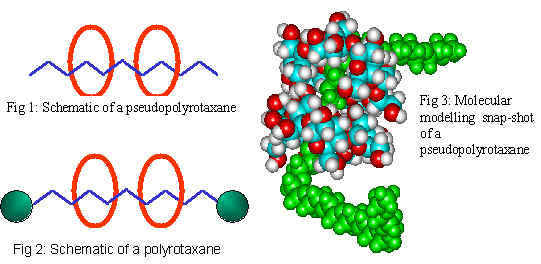Polyrotaxanes

Julie Joseph (previous student, left the group in 2002)
Rotaxanes are compounds composed of a linear molecule threaded through a cyclic species. In this project several cyclic sugar molecules host a polymeric guest forming a pseudopolyrotaxane (figs 1 & 3). The interactions between the cyclic and linear components are due entirely to physical bonds (e.g. hydrogen bonds and van der Waals forces) rather than any covalent bonds. As the cyclic constituents line up along the polymer, they interact and further stabilise the complex. Dethreading can be prevented by the attachment of bulky end groups, the resulting supramolecular complex is called a polyrotaxane (fig 2). This project aims to investigate the forces involved in the formation of these complexes, and their behaviour both in solution and at surfaces.
Potential industrial applications include synthesis of insulated molecular wires, where the polymer conducts electricity while the cyclic component acts as an insulator. Another important application is the attachment of drug molecules to the cyclic element, which are threaded onto a polymer and held in place by a biodegradable end group, forming a polyrotaxane. Enzymes within the body are able to break off the end groups and the rings can fall off releasing the drug.

Techniques used: NMR (high resonance, PFG and relaxation) and SANS.
This project is funded by the EPSRC and Reckitt Benckiser.